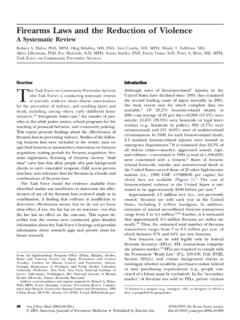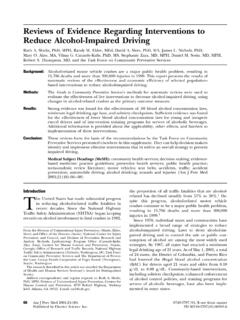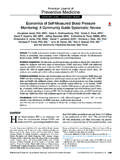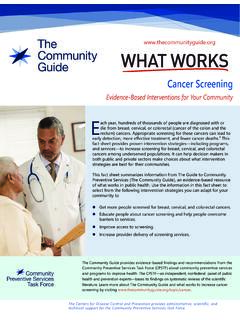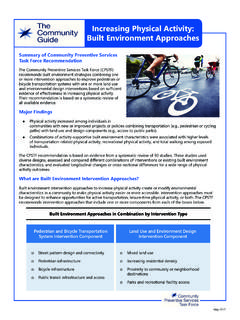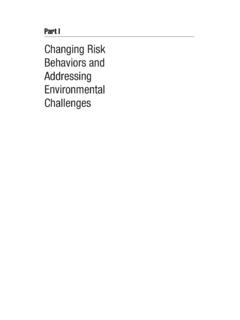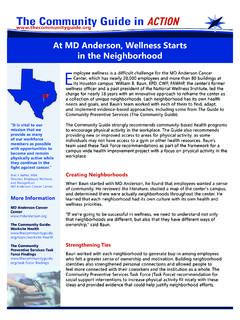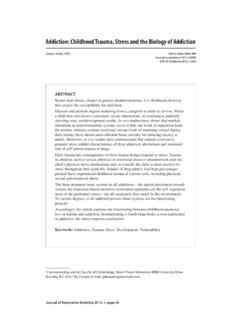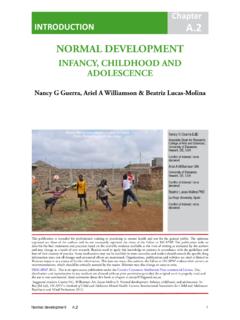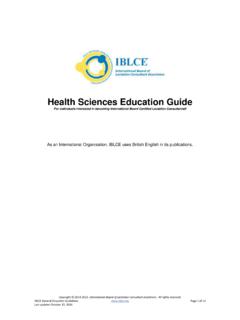Transcription of The Effectiveness of Early Childhood Development Programs
1 The Effectiveness of Early Childhood DevelopmentProgramsA Systematic ReviewLaurie M. Anderson, PhD, MPH, Carolynne Shinn, MS, Mindy T. Fullilove, MD, Susan C. Scrimshaw, PhD,Jonathan E. Fielding, MD, MPH, MBA, Jacques Normand, PhD, Vilma G. Carande-Kulis, PhD, MS,and the Task Force on Community Preventive ServicesOverview: Early Childhood Development is influenced by characteristics of the child, the family, andthe broader social environment. Physical health, cognition, language, and social andemotional Development underpin school readiness. Publicly funded, center-based, com-prehensive Early Childhood Development Programs are a community resource thatpromotes the well-being of young children.
2 Programs such as Head Start are designed toclose the gap in readiness to learn between poor children and their more economicallyadvantaged peers. Systematic reviews of the scientific literature demonstrate effectivenessof these Programs in preventing developmental delay, as assessed by reductions inretention in grade and placement in special education. (Am J Prev Med 2003;24(3S):32 46) 2003 American Journal of Preventive MedicineIntroductionChild Development is an important determinantof health over the life Early years oflife are a period of considerable opportunity forgrowth and vulnerability to harm.
3 Children s develop-mental trajectories are shaped by sources of resilienceas well as vulnerability. The cumulative experience ofbuffers or burdens is a more powerful determinant ofchildren s developmental well-being than single risk orprotective developmental opportunitiesestablish a critical foundation for children s academicsuccess, health, and general dimensions of child Development are self-regulation, the establishment of Early relationships,knowledge acquisition, and the Development of specificskills. These dimensions are affected by individualneurobiology, relationships with caregivers, and physi-cal and psychosocial exposures in the caregiving interaction of biology and the socialenvironment exerts a powerful influence on a child sreadiness to learn and on success in school, bothantecedents to health outcomes in later ,6In addition to frequently cited risk factors for devel-opmental dysfunction ( , premature birth, low birthweight, sequelae of Childhood infections, and leadpoisoning)
4 , exposure to an economically impoverishedenvironment is recognized as a social risk 9 Thesocioeconomic gradient in Early life is mirrored incognitive and behavioral the United States, where the rate of child povertyis substantially higher than that of most other majorWestern industrialized nations,11children are almosttwice as likely as any other age group to live in children under age 18, 16% (more than 11million children) live in families with incomes belowthe federal poverty threshold ($13,861 for a family ofthree in 2000).11 Early Childhood intervention pro-grams seek to prevent or minimize the physical, cogni-tive, and emotional limitations of children disadvan-taged by Early Childhood Development pro-grams are designed to improve the cognitive andsocial-emotional functioning of preschool children,which, in turn, influences readiness to learn in theschool setting.
5 Low family income and communitypoverty lead to racial and ethnic achievement gaps. Arecent Department of Education study shows, forexample, that 71% of white children entering kinder-garten could recognize letters, compared with 57% ofFrom the Division of Prevention Research and Analytic Methods,Epidemiology Program Office, Centers for Disease Control andPrevention (Anderson, Shinn, Carande-Kulis), Atlanta, Georgia; theTask Force on Community Preventive Services and Columbia Univer-sity (Fullilove), New York, New York; the Task Force on CommunityPreventive Services and University of Illinois, Chicago, School ofPublic Health (Scrimshaw), Chicago, Illinois; the Task Force onCommunity Preventive Services, Los Angeles Department of HealthServices, and School of Public Health, University of California, LosAngeles (Fielding), Los Angeles, California; National Institute onDrug Abuse, National Institutes of Health (Normand), Bethesda,MarylandAddress correspondence and reprint requests to: Laurie M.
6 Ander-son, PhD, MPH, Community Guide Branch, Centers for DiseaseControl and Prevention, 4770 Buford Highway, MS-K73, Atlanta GA30341. E-mail: names and affiliations of the Task Force members are listed atthe front of this supplement, and at J Prev Med 2003;24(3S)0749-3797/03/$ see front matter 2003 American Journal of Preventive Medicine Published by (02)00655-4 African-American readiness, partic-ularly among poor children, may help prevent thecascade of consequences of Early academic failure andschool behavioral problems: dropping out of highschool, delinquency, unemployment, and psychologicaland physical morbidity in young isa strong relationship between measures of educationalattainment and a wide range of adult disease Start, the national preschool education pro-gram designed to prepare children from disadvantagedbackgrounds for entrance into formal education inprimary grades, tries to bridge the achievement program is based on a comprehensive view of thechild that includes cognitive, social, emotional, andphysical Development .
7 As well as the ability of the familyto provide a supportive home environment. The ulti-mate goal of Head Start is To bring about a greaterdegree of social competence in pre-school childrenfrom low-income families. 17 This approach is reflected in Head Start s programobjectives17:1. Enhance children s growth and Strengthen families as the primary nurturers of Provide children with educational, health, and nu-tritional Link children and families to needed Ensure well-managed Programs that involve parentsin decision in 1965, Head Start has served more than 20million children in itsfirst 35 years.
8 In 2001 the federalbudget for Head Start was $6 billion,18and stateinvestments in Early Childhood initiatives grew to $ for Programs for potentialimpact of Early Childhood Development Programs issubstantial: in 1997, 62% of the more than 10 millionworking mothers in the United States had childrenunder age 6, and 13 million children attended earlycare and education Programs each results of this review can help to improve publichealth policies for young children. Children s readinessfor school encompasses a range of skills that childrenneed to are most critical for childrenwho are at high developmental risk due to to Community Preventive ServicesThe systematic reviews in this report represent the workof the independent, nonfederal Task Force on Com-munity Preventive Services (the Task Force).
9 The TaskForce is developing theGuide to Community PreventiveServices(theCommunity Guide) with the support of Department of Health and Human Services(DHHS) in collaboration with public and private part-ners. The Centers for Disease Control and Prevention(CDC) provides core staff support to the Task Force fordevelopment of theCommunity Guide. A special supple-ment to theAmerican Journal of Preventive Medicine, Introducing the Guide to Community Preventive Ser-vices: Methods, First Recommendations and ExpertCommentary, published in January 200021presentsthe background and the methods used in developingtheCommunity People 2010 Goals and ObjectivesHealthy People 201022draws attention to the intersectionof health outcomes, cognitive outcomes, and socialoutcomes and to the educational and income inequal-ities that underlie many health disparities.
10 Early child-hood Development opportunities are an intermediatedeterminant of individual and community health out-comes. Communities, states, and national organizationsare urged to take a multidisciplinary approach toachieving health equity an approach that involvesimproving health, education, housing, labor, justice,transportation, agriculture, and the environment, aswell as data collection itself. 22 Information from Other Advisory GroupsThefirst goal of the National Education Goals panel(created in 1994 by the Goals 2000: Educate AmericaAct) is By the year 2000, all children in America willstart school ready to learn.
